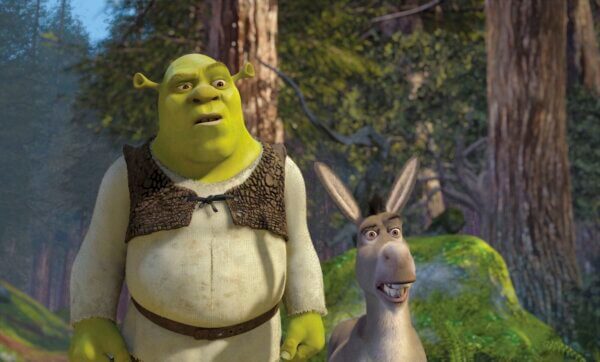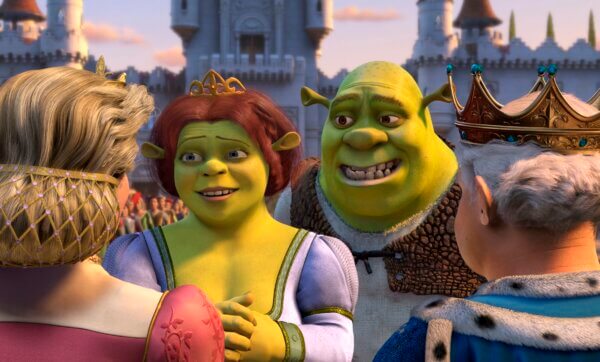Shrek 2 at 20 – how do we define ‘prestige’ animation?
The world had a very different relationship to Shrek in 2004. Before humanity crossed the rubicon into the smartphone and social media age and in the lead up towards the release of Shrek 2, we knew the ogre as a subversive, history-making Oscar winner. DreamWorks looked to attack that prestige angle even more, having the new film premiere at Cannes.
The past 20 years have aged Shrek into a cultural artefact that one would struggle to see as prestige. DreamWorks as a studio have continued to premiere the odd film at big European festivals but when Cannes had an animation-heavy (4 whole films!) lineup for their cancelled 2020 festival, none of their films were present. The festival’s 2024 edition will see them engage with animation in a significant way again, but to award Studio Ghibli with an honorary Palme d’Or. DreamWorks have also failed to pry any honours from the grip of The Academy in the past couple decades (unless you give them significant credit for Wallace & Gromit: Curse of the Were-Rabbit).
In the past few years our cultural definition of prestige has shifted, not just away from the corner of the animation industry Shrek pioneered and dominated, but away from DreamWorks’ brand as a whole. Not only that, but the exact things that made Shrek and Shrek 2 darlings of the animation industry in the early 2000s have become their fatal flaws.
Shrek entered the world at a time when the total number of CGI animated features was less than 20, with only seven coming from the US. The advent of making a film on a computer gave DreamWorks the appearance of being on the cutting edge alongside Pixar after the two studios released Antz and A Bug’s Life respectively within a month of each other. Shrek took things further by confidently depicting human characters, something Pixar was far from mastering and Disney hadn’t touched with their only CG feature at the time, Dinosaur.
Though DreamWorks’ early commitment to CGI saw them predict the future of Hollywood filmmaking, being one of the first to adopt new technology inherently means that the films themselves age rapidly. Not only has the novelty of CGI worn off, but the potato-ey graphics from the time can be tough to look at. CGI technology has also evolved to where it can be integrated better alongside traditional animation, the popularity of which indicates that audiences have reverted back to wanting a greater sense of craft from animated films. The issue of CGI vs 2D is much like the debate over shooting on digital vs film. Digital solves a lot of problems but there’s nothing like the tactility you get from something shot on film. This is why so many animated films from outside of Hollywood are getting more critical shine, they never gave up on 2D animation and have spent this whole time developing the craft further.
For DreamWorks, the bigger, more immediate threat came closer to home. Pixar’s 2003 effort Finding Nemo was a gorgeous and emotional look at underwater life and 2004’s The Incredibles is nothing short of a masterpiece. In comparison, DreamWorks’ Shrek 2 and Shark Tale looked cheap and crass, both losing out to The Incredibles at the 2005 Academy Awards.
Shrek’s distaste for the classic Disney story structure and tropes gave it a subversive edge and opened mainstream animation to a new way of telling stories within the medium. Shrek was seen as a giant killer, taking on the establishment not only through the content of the film but in the box office. In his book DisneyWar, James B. Stewart discusses the effect Shrek’s success had on Disney after it eclipsed the release of Atlantis.
These developments were especially worrisome to John Musker and Ron Clements, who were deep into work on Treasure Planet, another attempt at an action-adventure animated feature. Their target audience of preteen and teenage boys apparently still associated hand-drawn 2D animation with children’s fare and wanted no part of it. [President of feature animation Thomas] Schumacher met with two thousand employees in groups of fifty or less to discuss plans for cost cuts, more computer-generated projects, and other ‘drastic’ changes,’ including layoffs and salary reductions. Morale plummeted.
– James B. Stewart, DisneyWar
Katzenberg and Shrek had single-handedly rewired the minds of their audience and ushered in a new era for animation. However, the stick DreamWorks used to beat Disney was eventually turned against them. Shrek’s protests against Disney took the form of pop culture references (which always age well), fart jokes, dance parties and calling out fairytale bullshit, while Pixar continued to make very good films with better visuals and better writing that allowed them to communicate different messages to adults and children. Sincerity ages better than cynicism, landing us in a time where the early 2000s are seen as both the Pixar golden years and the ‘dance party’ era of animation.
As the preteens who had their minds unlocked by Shrek grew up and began to live increasingly in cyberspace, the reputation of Shrek completed its transition from juggernaut to meme. DailyDot’s 2014 investigation into why Shrek became such an Internet phenomenon sheds light on how the irony-poisoned culture of the 2010s took something like Shrek, ostensibly for kids, and turned it into something more… sinister? Goofy? How do you really describe Shrek is Love, Shrek is Life?
For this generation, Shrek represented a childhood milestone that had to be ridiculed, and the early CGI, the dance parties and sense of humour made it an easy target. The irony being that Shrek’s ironic take on Disney fairytales became the subject of irony on the Internet. The enduring sensation of Frozen proves that society has somewhat wrapped back around to the appreciation of the Disney princess, just as we wrapped back around to wanting more 2D animation in our films.
Is the rise and fall of Shrek’s reputation in our culture a sign that ‘prestige animation’ is a myth? Or is this the doomed path for anything that truly shakes up the establishment? In some ways, Shrek won. Mainstream American animation is almost exclusively CGI, remnants of its sense of humour still persist in animated features, Puss In Boots: The Last Wish showed audiences something they hadn’t quite seen before and Disney are still undergoing an identity crisis. Equally, in the eyes of most, Shrek and Shrek 2 are consigned to meme history, movies that are more easily enjoyed ironically.
Cannes were right to feature Shrek 2 in competition for their 2004 festival. This franchise is worthy of its place in animation history. Being the first ever winner of the Academy Award for Best Animated Feature is reason enough, but without Shrek, for how much longer would Western animation have bent to the knee of the traditional Disney fairytale structure? These movies taking over the world for a little while was a necessary watershed moment for Hollywood animation to find its identity. This period of soul searching has conjured some masterpieces and some CGI monstrosities, but we’ve finally arrived in a promising place.





